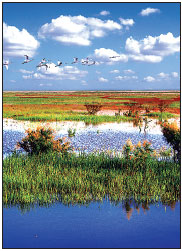Wetland protects rare birds
When winter arrives and no birds can be found in the city, leaving the urban streets a somehow lonely and lifeless place, the wetland of the Yellow River Delta offers a completely different atmosphere, even on the coldest days.
From October to March, the Yellow River Delta wetland becomes a migratory pit stop for countless birds of varied kinds on their winter journey to and from the south, making the nature reserve a fascinating place for bird watchers.
The Yellow River Delta National Nature Reserve in Dongying, Shangdong province, comprises the largest and youngest wetland ecosystem in China. It provides a temporary but crucial shelter for the migratory birds in Northeast Asia and the West Pacific ring. It is also China's largest river delta nature reserve, occupying an area of 1,530 square kilometers.
In 1992, the State Council established the natural reserve for the wetland ecosystem and its rare animal species. The delta wetland has played a key role in the protection of these rare species ever since.
So far, 368 kinds of wild birds have been identified in the reserve, among which more than 63 kinds are under the national protected animals list, including the red-crowned crane, the whooper swan and the oriental stork. Earlier this year, 196 baby oriental storks were hatched in the reserve.
"This year, the number of newborn oriental storks broke the previous record. Since the reserve was built, we have hatched 937 baby birds in total," said Zhao Yajie, a researcher at the Yellow River Delta National Reserve in a previous interview with China News. "The reserve has made a big difference in the protection of rare species."
According to Bu Naibin, a staff member at the natural reserve, black-headed gulls, also called "the elf of the wetland", also nest in the reserve.
"Black-headed gulls are very picky about their reproduction environment," said Bu. "Even slight pollution will cause the eggs to fail to hatch."
In 2010, the reserve started a protection project for the black-headed gulls. The project has seen effective progress, as 3,593 nests were found in the reserve and about 7,200 black-headed gulls were hatched in Dongying in 2016.
Besides wild birds, the delta also has a stunning natural landscape, including the largest locust forest on the North China Plain. The wetland has been ranked as one of the six most beautiful wetlands in China by the Chinese National Geography magazine.
The abundant natural resources have also made the Yellow River Delta a popular travel destination. Benefiting from stunning views of the delta, the wetland and the wilderness, the area has attracted a great number of tourists, bringing billions of yuan in profit to Dongying.
To further boost the tourism industry and preserve the environment, the city government has allocated 1.5 billion yuan ($215.9 million) to develop the tourism area and brand the city as "the Yellow River town". In the natural reserve, a number of bird-watching pavilions, wetland parks and tourism centers have been established to help meet this goal.
Last year, the city hosted more than 13 million tourists, generating 12.5 billion yuan in revenue.
|
|
(China Daily 12/23/2016 page12)















